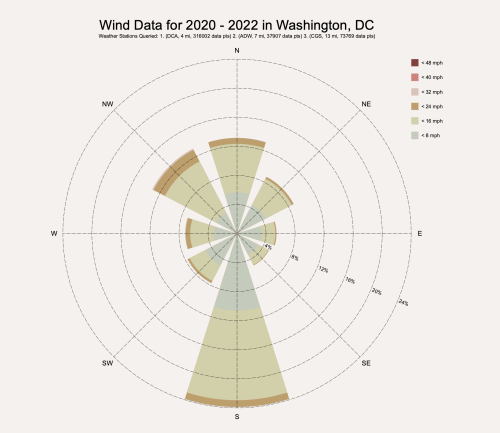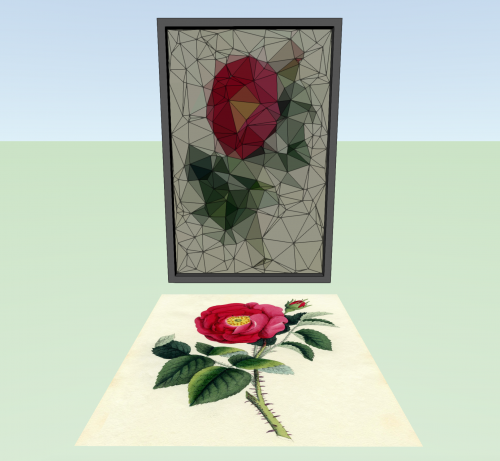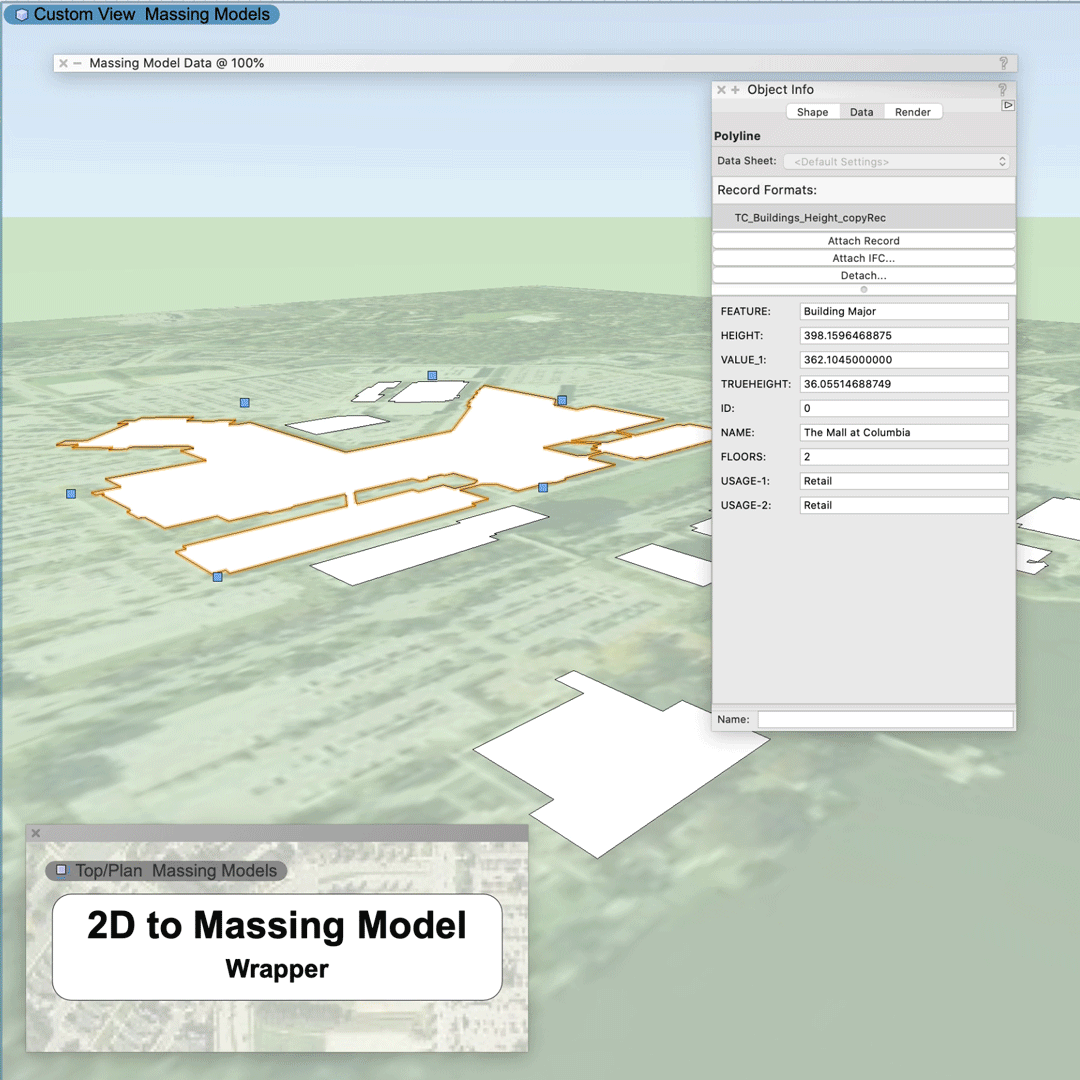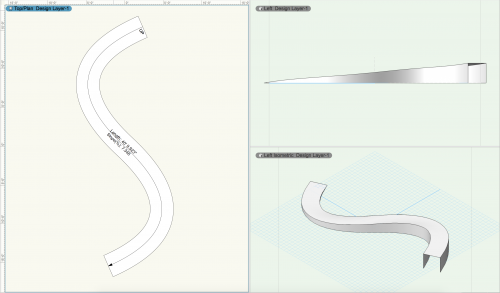-
Posts
335 -
Joined
-
Last visited
Content Type
Profiles
Forums
Events
Articles
Marionette
Store
Files posted by SBarrettWalker
-
Sun Path Diagram
By SBarrettWalker in Marionette - Objects
This is a Marionette Object that downloads weather data from the internet based on the address/location you enter into the OIP. The data this graphic shows is the angle of the sun path at different times of the year. You must have a valid internet connection to use this MO.
696 downloads
-
Temperature Chart
By SBarrettWalker in Marionette - Objects
This is a Marionette Object that downloads weather data from the internet based on the address/location you enter into the OIP. The data this graphic shows is the max, average, and min temperatures per month at a specific location. You must have a valid internet connection to use this MO.
296 downloads
-
Precipitation Chart
By SBarrettWalker in Marionette - Objects
This is a Marionette Object that downloads weather data from the internet based on the address/location you enter into the OIP. The data this graphic shows the peak one hour rainfall and the total monthly rainfall per month. You must have a valid internet connection to use this MO.
214 downloads
-
Wind Rose
By SBarrettWalker in Marionette - Objects
This is a Marionette Object that downloads weather data from the internet based on the address/location you enter into the OIP. You must have a valid internet connection to use this MO. There will be more weather analysis graphs to come! Here is a video that shows how the Wind Rose works: Wind Rose Video.mp4
294 downloads
-
Test Proximity and Text to 3D Loci
By SBarrettWalker in Marionette - Networks
These scripts are similar to networks I posted in January of 2019. Here is the link to the previous post.
The Test Proximity script is the same one as in the older post, but has been updated to Vectorworks 2023. These scripts are primarily for Landmark users - they can be used to convert a file that contains 2D geometry with unassociated text labels to 3D loci (if the text is a number value representing an elevation). To use these wrappers, first group the geometry and text labels you want to convert and give the group a name in the Name field of the OIP. Then copy/paste the wrappers into the file and set the parameter "Group Name" in the two wrappers to the name you gave your group. Next, run the Test Proximity wrapper. Lines between text and geometry will appear. If there is a line between each geometry and label pair, you can run the next wrapper. If there are multiple lines from a single piece of geometry to more than one text label, adjust the text labels in your group, placing these particular labels closer to their respective geometries and rerun the Test Proximity wrapper until there is a single line for each text and geometry pair. Finally, run the Text to 3D Loci wrapper to create 3D loci at the same location as the 2D geometry with a z-height that matches the text value.
85 downloads
-
Algorithms-Aided Design in BIM Software Webinar Files
By SBarrettWalker in Marionette - Networks
Here are the files used in the webinar, Algorithms-Aided Design in BIM Software. "Sample Script" is the file that was used for the full demo, and "Panelization" and "The Greyhound 2" were used as examples.
136 downloads
(0 reviews)0 comments
Submitted
-
Infographics
By SBarrettWalker in Marionette - Networks
This is an old file that I have recently resurrected. It is one of the first files I ever created and represents my favorite way to use Marionette: infographics. I thought I had posted it here, but I can't find it, so I figured I would post it again. This file contains some custom infographics that I created based off of the polys in this file that have records attached. I have included a second layer that has some chart nodes from the default library.
107 downloads
(0 reviews)0 comments
Submitted
-
Print Parametric Record
By SBarrettWalker in Marionette - Menu Commands
This menu command can be used on a selected parametric -- or plug-in -- object. Most plug-in objects in Vectorworks have a parametric record and this command can be used to see what the field names and field values are for that particular object. The values in these fields generate the shape and attributes of the object. I use this menu command to find out what fields a particular object has, so I can use those fields to incorporate that object into my networks.
125 downloads
(0 reviews)0 comments
Submitted
-
Marionette 101 Training Files
By SBarrettWalker in Marionette - Networks
Here are files that I use to do Marionette training. I thought that it would make sense to add them to the forum because they are useful in their own right, even without me talking through them. The Marionette 101 and 102 files go step by step through building Marionette networks. In both files, you can cycle through the Saved Views to see each iteration of the network and what geometry it produces. When you create a Marionette network you don't necessarily place all the nodes linearly from left to right, you build it in chunks of functionality, and the nodes that make up those chunks don't always follow from left to right like words on a page. Everybody might build their networks a little differently, but in these two networks, I show how I would solve these particular problems. The first network is a series of cubes that grow in size and that series can grow and rotate. This network has also been converted to a Marionette object and contains sliders in the final version. The second network is a series of squares that have a spectrum of colors applied to them. Because several steps of this network do not generate geometry, Saved Views have been added showing Print Debug nodes that display the values of the network.
310 downloads
(0 reviews)0 comments
Submitted
-
Curve Map Wrapper
By SBarrettWalker in Marionette - Nodes
This is a wrapper that serves a similar function to Grasshopper's Graph Mapper component. To use the wrapper, connect it to a network, give it a minimum and maximum value for its domain range, the number of values you want in your list, and use a Name node to connect a drawn NURBS curve to the hCurve input. When you reshape the curve and run the network, the output list of values will change. You can use these values to shape, scale, array, or anything else in your network. Within the Curve Map Wrapper file is an example of a railing Marionette object and in the second file there is a vase Marionette object. Both use the Curve Map wrapper. This wrapper can be used in Marionette objects or regular Marionette networks.
201 downloads
-
Festoon Strings
By SBarrettWalker in Marionette - Objects
This is a Marionette object that creates an array of festoon strings. The Marionette object has four control points (one for each corner) that allow you to place each corner at a specific location and height. You can adjust the number of strings, the number of arcs in the strings, and the overall depth of the arc. The objects arrayed along the festoon strings are symbols so you can use the ones provided or create your own. The symbols provided have glow or light objects in them, so they can be used in renderings.
1,403 downloads
-
Scissor Lift
By SBarrettWalker in Marionette - Objects
This Marionette object is a Scissor Lift PIO. You can place the Scissor Lift in your drawing and set the height via a Slider in the OIP. (See video.) All the different parts of the Lift are different symbols, and the Marionette script places each symbol at a particular insertion point and rotation based on the value of the Slider. If you wish to share the object, make sure that you share the entire symbol folder that holds all of its accompanying parts.
This object was based on a symbol created by @barnes2000. Thanks Scott for letting me play!
1,363 downloads
-
JLG Condor 60
By SBarrettWalker in Marionette - Objects
This is another Marionette object based on a symbol belonging to @barnes2000. (Thanks Scott!) He has built a bunch of cool crane and lift symbols. This one is an Articulating Boom Lift that has seven different rotation or extension articulations. Each has a Slider in the OIP that allows you to set its angle or extension. (See video.) This Marionette object works by placing the different parts of the Lift as symbols in the drawing at a particular insertion point and rotation based on the values of the Sliders. Each symbol has named loci that are used to locate the object in the drawing space and in relation to the other parts. The loci are on an invisible class (so don't delete the class from the drawing). The object updates pretty quickly for having so many variables. If you wish to share the object to another file, make sure that you import the entire symbol folder.
Unlike the Scissor Lift, this object is not built from hybrid symbols because hybrid symbols cannot be rotated around the x- or y-axis. If you wish to convert it to a hybrid object, you could place it inside an Auto Hybrid, but this will make it a much bigger object (memory-wise), and you would only be able to edit the object from inside the Auto Hybrid.
1,169 downloads
-
Custom Stage
By SBarrettWalker in Marionette - Objects
This is a path-based Marionette object that creates a stage. This is a little different from the Create Stage... command as it allows you to make the stage from any shape and to choose symbol-based profiles for the frame, bracing and legs. It also uses a leg pocket symbol. You can edit the existing symbols to customize this stage or you can create your own library of symbols to use.
294 downloads
-
Image-Based Triangulated Panel
By SBarrettWalker in Marionette - Objects
This is a Marionette object that uses several python libraries - Pillow, NumPy, and SciPy - to create a triangulated panel that takes its colors from the pixels of an image.
The color for each triangle is the average RGB value for all the pixels that would fall within that shape if the picture and the panel were aligned.
To create this object I used some nodes that @Marissa Farrell created, a couple from this file and one node from this file.
As this Marionette object contains external libraries, you may see some prompts to download libraries the first time you make a change. Just click OK when prompted. Unfortunately, this object does not work on PC running Vectorworks 2020. It does however work on a PC running Vectorworks 2021.
There are two files in this post, one with just the Marionette object and another that uses the Marionette object in an actual model.
147 downloads
-
2D to Massing Model
By SBarrettWalker in Marionette - Networks
This file contains a Marionette network that converts 2D polys into Massing Models. It reads the Record Format info attached to the poly and uses that information to create the Massing Model. It also transfers all attached Records to the Massing Model. This network is useful for converting shapefile data into Massing Models. To use the network, select the wrapper and make sure that all the fields in the Object Info palette correspond correctly to the objects that you want to convert. All of the info that you want to use to create the Massing Model must be in a single record, but all attached records will be transferred over by the script.
Also included in the file is a worksheet that allows you to calculate Floor Usage Data for each floor of a multistory building. If you have one type of usage on the first floor, and a different type of usage on the upper floors, you can calculate that in the worksheet. (If you have more than two types of usage, it can only calculate the first two types.) To change the usage type in the worksheet, just type the name of the usage type, like "Retail" or "Residential" into the top row of one of the Area by Usage Type Columns. The lower rows will adjust appropriately.
180 downloads
-
Gravity Wall
By SBarrettWalker in Marionette - Objects
This Marionette object creates a Gravity Wall based off of a folder of symbols and a poly line. The poly line is the path of the Marionette object - to edit the poly line, right-click on the object and choose “Edit Control Geometry.” Within the Object Info palette (OIP) of the Marionette object, you can set the overall wall height, the angle at which the wall is slanted, and the pattern of the different symbols that will make up the wall. You can also offset this pattern on each row.
It’s important that the only symbols in the referenced folder be ones that you wish to use as blocks in the wall, and that each block symbol should have the same Z height - if the blocks are different heights, the wall will not be able to accommodate them.
In this file, there is also a network form of the script. This functions in a similar way to the Marionette object, except it creates a wall based off of a referenced poly line (a poly line that already exists in the document) instead of control geometry. To reference a poly line, give that poly a name in the Name field in the OIP and then reference that same name in the network.
GravityWall.mp4231 downloads
-
Create Stories
By SBarrettWalker in Marionette - Networks
Creating stories, levels, and layers can be a tedious process, especially for tall, multistory projects. This wrapper allows you to automate that process based on an overall building height, typical floor heights, and default levels. You can create up to 4 Layer Levels and 2 Layerless Levels. To create fewer Levels, leave any of the Layer 1, Layer 2, Layer 3, Layer 4, Layerless Level 5, and/or Layerless Level 6 fields blank.
To use this script in a new file, simply import the wrapper into the file, place it in the drawing, and run the script. The settings of the script are very similar to the levels and layers created in the Vectorworks template, but you can customize them in the OIP of the wrapper. To change the Story suffixes and Story names, double click on the wrapper and the select the Get Story Names node. There are settings that you can change in the OIP of this node as well.
NOTE: Existing stories and story-associated layers that match the names of the new stories and layers will be deleted every time you run this script. Existing stories that DO NOT match the names of the new stories will not be deleted but may interfere with the creation of new stories. It is recommended that this script is run in a file without existing stories, levels, or story-associated layers.
143 downloads
-
Panel Arrays
By SBarrettWalker in Marionette - Networks
In Vectorworks, there is a command that allows the user to build a surface array, i.e. to array a symbol across a NURBS surface. This is a powerful tool, but creating patterns with multiple symbols is currently missing as an option in the software.
With this in mind, these two Marionette scripts are meant to help create panel patterns on a wall with existing 3D symbols:
· The wrapper “Panelization with Rotation” arrays a single symbol across a surface, but can apply a rotation to that symbol in either a user-defined pattern or randomly.
· The wrapper “Panelization with Multiple Panels” arrays multiple symbols across a surface in either a user-defined pattern or randomly.
For both scripts, the horizontal and vertical reveals between panels can be set separately, allowing for quick visualization of multiple paneling design options.
These scripts only work when the NURBS surface is flat and the face is rectangular — the symbols will not follow a curved surface. This is meant to be used for panelized walls, which are much more likely to be flat. (The surface however does not have to be vertical; it can be slanted or horizontal.)
The panels are distributed from left to right, top to bottom across the surface — if the pattern does not fit exactly across the surface, there will be extra room left at the right and/or bottom edge of the surface. When paneling a wall, it is more likely that the full surface or the reveals will be resized to fit the appropriate number of panels versus trimming the panels along one side.
205 downloads
-
Barn Door
By SBarrettWalker in Marionette - Objects
Here is a Marionette object that functions as a schematic Barn Door. It opens and closes with a slider and has separate 2D and 3D geometry. The wheel and hanger are a symbol, so if you wish to change their look you can edit the current symbol or create a new one. The insertion point of the symbol must be where the wheel touches the track.
460 downloads
-
NanaWall WA67
By SBarrettWalker in Marionette - Objects
This is a Marionette Object that can be used to simulate the WA67 Aluminum Clad Wood Folding NanaWall door. It allows you to set the panel width and height as well as the configuration and system. Based on these parameters, it calculates the overall frame width and height and creates a record format for the door that can be called in a worksheet. The insertion point of the door is the center left of the door, so if you choose a configuration with a different number of panels or you change the panel width, the PIO will extend or contract from the left (instead of from the center like regular door PIOs in Vectorworks). I would welcome feedback on the usefulness of this - is there something you would like it to do that it doesn't do? What does it do that you don't need it to do? As far as other types of NanaWalls (such as sliding panels), I am trying to figure out a way to script those as well.
574 downloads
-
Test Proximity and Associate Existing Trees
By SBarrettWalker in Marionette - Networks
This file is most useful for Landmark users but could be adapted to other plugin objects (PIOs). The purpose of these scripts are to take surveys of existing trees that consist of "dumb" data - pieces of geometry and text to label trees on a survey - and convert it into Existing Trees with the relevant text data associated.
The first network, "Test Proximity," runs a check to make sure that each piece of text is closest to its associated piece of geometry. This is necessary to make sure that the second script will work properly.
The second network takes the center of each piece of geometry and places an Existing Tree there. It will use the saved red symbol in the Resource Manager as a template, so if you use particular default settings for your Existing Trees, you can edit the red symbol. (Some day maybe there will be an Existing Tree Style!) The network will also transfer the text data to your chosen field of the Existing Tree PIO. In this network, it is set to transfer to the Tree No data field.
This network could be adapted to other PIOs if needed.
131 downloads
- landmark
- existing tree pio
- (and 1 more)
(1 review)0 comments
Submitted
-
Room Screen
By SBarrettWalker in Marionette - Objects
Here is another Marionette Object with articulation. It is a simple room screen that has three panels with two hinge points. Each panel can be given an angle of anything between 0 and 90.
83 downloads
(0 reviews)0 comments
Submitted
-
Asterisk Wall Clock Object
By SBarrettWalker in Marionette - Objects
This is a Marionette object that is a wall clock. The time of the clock can be set by sliders in the OIP. The three pieces of the clock: the face, the hour hand, and the minute hand are all symbols that can be changed. The only important aspect of the symbols is that the XZ value of the insertion point for all the symbols be at the center of rotation and the Y value be relative to the clock face.
37 downloads
(0 reviews)0 comments
Submitted
-
Curved Ramp
By SBarrettWalker in Marionette - Objects
This Marionette object is a path-based ramp. The path is a bezier curve and can be reshaped by double-clicking on the object. The 3D ramp is built by lofting NURBS curves and the 2D text can be turned on or off in the Object Info palette.
This ramp uses the new Valve node in Vectorworks 2018 which means it can't be exported back to 2017.
499 downloads




























